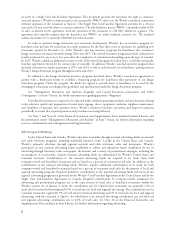Wendy's 2015 Annual Report Download - page 18
Download and view the complete annual report
Please find page 18 of the 2015 Wendy's annual report below. You can navigate through the pages in the report by either clicking on the pages listed below, or by using the keyword search tool below to find specific information within the annual report.approximately 315 restaurants during 2016. There are a number of risks associated with the system optimization
initiative, including the difficulty in predicting the ultimate costs associated with the sale of restaurants, employee
termination costs, the timing of payments made and received, the results of negotiations with landlords, the impact of
the sale of restaurants on ongoing operations, any tax impact from the sale of restaurants, and the future impact to the
Company’s earnings, restaurant operating margin, cash flow and depreciation. If Wendy’s is unable to manage these
risks effectively, our business and financial results could be adversely affected.
Further, Wendy’s generally retains ownership or the leasehold interest to the real estate when it sells restaurants
under the system optimization initiative and leases or subleases the real estate to franchisees. This increases the risks
described above under the heading “Our financial results are affected by the operating results of franchisees.”
Wendy’s may be unable to manage effectively the acquisition and disposition of restaurants, which could
adversely affect our business and financial results.
Wendy’s has from time to time acquired the interests of and sold Wendy’s restaurants to franchisees. Wendy’s
will continue to evaluate strategic acquisitions of franchised restaurants and strategic dispositions of company-owned
restaurants to existing and new franchisees. The success of these transactions is dependent upon the availability of
sellers and buyers, the availability of financing, and the brand’s ability to negotiate transactions on terms deemed
acceptable. In addition, the operations of restaurants that the brand acquires may not be integrated successfully, and
the intended benefits of such transactions may not be realized. Acquisitions of franchised restaurants pose various risks
to brand operations, including:
• diversion of management’s attention to the integration of acquired restaurant operations;
• increased operating expenses and the inability to achieve expected cost savings and operating efficiencies;
• exposure to liabilities arising out of sellers’ prior operations of acquired restaurants; and
• incurrence or assumption of debt to finance acquisitions or improvements and/or the assumption of
long-term, non-cancelable leases.
In addition, engaging in acquisitions and dispositions places increased demands on the brand’s operational and
financial management resources and may require us to continue to expand these resources. If Wendy’s is unable to
manage the acquisition and disposition of restaurants effectively, our business and financial results could be adversely
affected.
Current restaurant locations may become unattractive, and attractive new locations may not be available for a
reasonable price, if at all.
The success of any restaurant depends in substantial part on its location. There can be no assurance that our
current restaurant locations will continue to be attractive as demographic patterns change. Neighborhood or
economic conditions where our restaurants are located could decline in the future, thus resulting in potentially
reduced sales in those locations. In addition, rising real estate prices in some areas may restrict our ability and the
ability of franchisees to purchase or lease new desirable locations. If desirable locations cannot be obtained at
reasonable prices, the brand’s ability to execute its growth strategies could be adversely affected.
Wendy’s leasing and ownership of significant amounts of real estate exposes it to possible liabilities and losses,
including liabilities associated with environmental matters.
As of January 3, 2016, Wendy’s leased or owned the land and/or the building for 632 company-owned
Wendy’s restaurants. Wendy’s also owned 340 and leased 720 properties that were either leased or subleased
principally to franchisees as of January 3, 2016. Accordingly, we are subject to all of the risks associated with leasing
and owning real estate. In particular, the value of our real property assets could decrease, and costs could increase,
because of changes in the investment climate for real estate, demographic trends, supply or demand for the use of the
restaurants, which may result from competition from similar restaurants in the area, and liability for environmental
matters.
Wendy’s is subject to federal, state and local environmental, health and safety laws and regulations concerning
the discharge, storage, handling, release and disposal of hazardous or toxic substances. These environmental laws
15
























